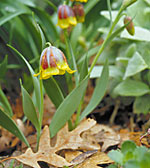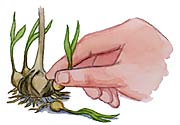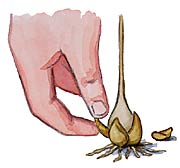
 Bulblets — Sometimes a fritillaria bulb forms suckers at the base of the stem, just above the mother bulb. You’ll notice tiny foliage sprouting from these bulblets. In the fall, bulblets can be carefully broken off or cut away with a sharp knife. Plant them directly into the flower bed. The larger the bulblet, the sooner it will bloom.
Bulblets — Sometimes a fritillaria bulb forms suckers at the base of the stem, just above the mother bulb. You’ll notice tiny foliage sprouting from these bulblets. In the fall, bulblets can be carefully broken off or cut away with a sharp knife. Plant them directly into the flower bed. The larger the bulblet, the sooner it will bloom.
 Scales — Fritillarias are made up of layers of scales, much like lilies. However, fritillarias usually have only a few scales, whereas lilies have several. In late summer or fall, after the stem has turned yellow and gone dormant, dig the fritillaria bulbs from the soil. Carefully break off one of the larger outer scales per bulb, as close to the base as possible.
Scales — Fritillarias are made up of layers of scales, much like lilies. However, fritillarias usually have only a few scales, whereas lilies have several. In late summer or fall, after the stem has turned yellow and gone dormant, dig the fritillaria bulbs from the soil. Carefully break off one of the larger outer scales per bulb, as close to the base as possible.
Dust the mother bulbs with a powdered fungicide, such as captan, and replant them immediately. Wash the soil from the scales and lay them on paper towel. Dust them with the powdered fungicide and put them in a shady spot to dry for a day.
Put a handful of moist vermiculite into a plastic bag, add the treated scales and seal the bag. Poke a few small holes in the bag for ventilation and store it in a dark closet that stays around 70 degrees F for the winter. Check the bag occasionally and mist it to make sure the contents don’t dry out.
Within six to eight weeks, tiny bulblets should have formed at the base of each scale. Plant them, scale and all, in well-drained, sandy soil just under the surface. Once leaves emerge, fertilize with a half-strength tomato fertilizer. This will help your bulbs get a faster start.
Now it’s time to be patient — it may be a few years before your little bulblets flower.
















